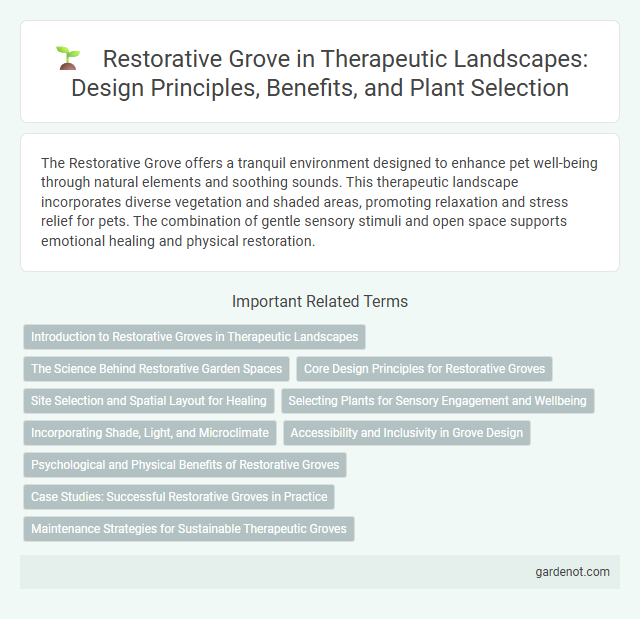The Restorative Grove offers a tranquil environment designed to enhance pet well-being through natural elements and soothing sounds. This therapeutic landscape incorporates diverse vegetation and shaded areas, promoting relaxation and stress relief for pets. The combination of gentle sensory stimuli and open space supports emotional healing and physical restoration.
Introduction to Restorative Groves in Therapeutic Landscapes
Restorative groves serve as vital components in therapeutic landscapes, offering immersive natural environments that promote psychological well-being and stress reduction. Characterized by clusters of trees and diverse plant species, these groves provide shaded, tranquil spaces that facilitate mental restoration and physical relaxation. Empirical studies highlight how exposure to restorative groves enhances mood regulation, cognitive function, and overall health outcomes in healthcare and community settings.
The Science Behind Restorative Garden Spaces
Restorative groves harness biophilic design principles and sensory stimuli to reduce cortisol levels and enhance parasympathetic nervous system activity, promoting mental relaxation and emotional well-being. Research indicates that exposure to natural environments with diverse vegetation and fractal patterns facilitates attention restoration and cognitive recovery. Neuroimaging studies highlight increased alpha brainwave activity and decreased amygdala responses in individuals immersed in garden spaces, demonstrating the therapeutic impact of these settings on stress reduction and mood stabilization.
Core Design Principles for Restorative Groves
Restorative groves prioritize core design principles such as creating a multisensory environment with diverse plant species, ensuring accessibility through gentle pathways, and incorporating natural elements that promote stress reduction and mental rejuvenation. Emphasis on seasonal variation and spatial complexity supports ecological health while enhancing visitor engagement and well-being. Integrating these principles fosters a therapeutic landscape that encourages reflection, relaxation, and cognitive restoration.
Site Selection and Spatial Layout for Healing
Restorative groves are strategically selected based on factors such as natural light exposure, air quality, and proximity to water sources to maximize therapeutic effects. The spatial layout emphasizes clustered trees, walking paths, and seating areas that encourage mindfulness and social interaction, supporting mental restoration. Incorporating diverse plant species enhances sensory engagement and biodiversity, creating an immersive healing environment.
Selecting Plants for Sensory Engagement and Wellbeing
Selecting plants for sensory engagement and wellbeing in a restorative grove involves choosing species that stimulate multiple senses, such as lavender and rosemary for their calming scents, and ornamental grasses for tactile interaction. Incorporating diverse textures, colors, and seasonal blooms enhances the therapeutic impact, fostering relaxation and mental restoration. Native and drought-tolerant plants improve ecological sustainability while supporting sensory stimulation in the therapeutic landscape.
Incorporating Shade, Light, and Microclimate
Integrating shade trees and dappled light within a restorative grove enhances comfort and supports physiological healing by moderating temperature and reducing stress. Selecting native species tailored to local microclimate conditions optimizes air circulation and humidity control, creating an inviting environment for relaxation and recovery. Thoughtful layering of canopy and understory vegetation fosters biodiversity while providing varied light intensities critical for mental restoration.
Accessibility and Inclusivity in Grove Design
Designing restorative groves prioritizes accessibility by incorporating smooth pathways, ample seating, and clear signage to accommodate individuals with diverse mobility needs. Inclusive elements such as sensory gardens, varied textures, and shaded areas ensure engagement for all ages and abilities, enhancing therapeutic benefits. Strategic placement of entrances and adaptive features fosters a welcoming environment that supports mental well-being and community connection.
Psychological and Physical Benefits of Restorative Groves
Restorative groves provide significant psychological benefits by reducing stress levels and enhancing mood through immersive natural environments that promote relaxation and mental clarity. Physically, these groves improve cardiovascular health and immune function by encouraging gentle exercise and exposure to clean, oxygen-rich air. The combination of sensory stimuli, including calming sounds and natural scents, supports holistic healing processes and overall well-being.
Case Studies: Successful Restorative Groves in Practice
Successful restorative groves demonstrate significant improvements in mental health and stress reduction through immersive natural settings. Case studies highlight projects such as the Healing Grove at Mount Sinai Hospital and the Green Haven Restoration Grove in Singapore, where designed landscapes integrate native flora to promote relaxation and cognitive restoration. Measurable outcomes include decreased cortisol levels, enhanced mood, and increased social interaction among users, validating the therapeutic potential of restorative groves.
Maintenance Strategies for Sustainable Therapeutic Groves
Effective maintenance strategies for sustainable therapeutic groves involve regular pruning to encourage healthy growth and prevent disease, ensuring the longevity of restorative tree species such as oaks, maples, and native evergreens. Soil health is preserved through mulching and organic fertilization, promoting beneficial microbial activity that enhances plant resilience and therapeutic benefits. Integrated pest management and controlled irrigation systems optimize grove vitality while minimizing environmental impact, supporting the grove's role as a healing landscape.
Restorative grove Infographic

 gardenot.com
gardenot.com